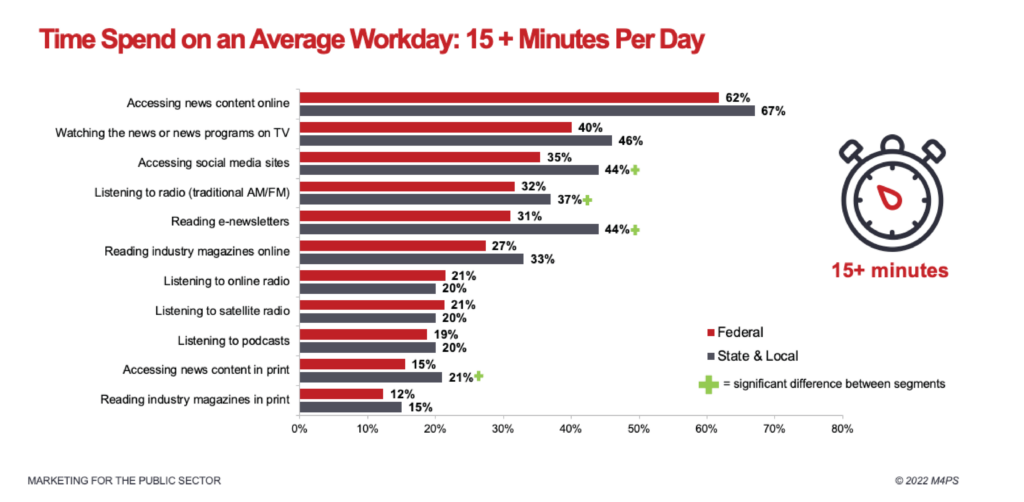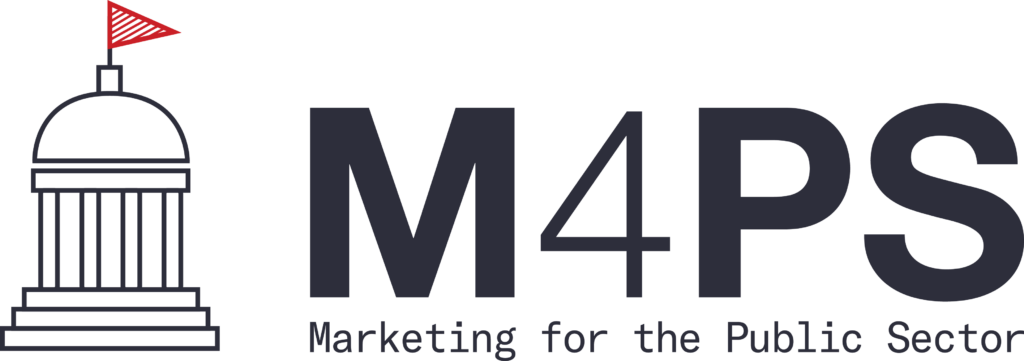News
2022 Update
STAY CONSISTENT TO REACH TARGET AUDIENCES
In the last few years the way we seek and receive news has been changing and evolving faster than ever. Between the COVID-19 pandemic more or less forcing many companies to adapt to work from home trends, team collaboration needs, and an industry wide push toward cloud, things are getting more digital by the day.
While many people still start mornings off with a newspaper, listening to the radio on the commute to work, or gathering around the TV for the evening news, they don’t confine news consumption to those times. Increasingly, most likely due to the ubiquity of remote work and the convenience of cell phones and apps, people are engaging with news outlets and seeking out important updates from various digital sources throughout the day, a trend public sector marketers can (and should) take advantage of.
LEARN MORE MEDIA TRENDS
Part 1 of the 2-part 2022 Marketing for the Public Sector (M4PS) study looks at media engagement among both federal and state/local audiences.
Brought to you in a neatly packaged two part study, M4PS, called “maps” for short, focuses on the digital world around us. A first look at highlights from the M4PS study were presented to attendees at Government Marketing University’s GAIN conference, and part one of the full report will be available to purchase in November.
STAY UP ON TRENDS AND BE WILLING TO ADJUST ACCORDINGLY
Market Connections will continue to look at trends and impacts on federal and state and local employees’ media usage and preferences. Learning where your potential customers go for news and information can be fabulously useful in building a marketing plan. A better understanding of demographics, “go-to” news sources and most trusted social media channels can help you consistently put your message where their mind is.
Federal and state/local customers, just like the rest of us, are affected by outside factors. Marketers can’t always rely on by-the-book and tried-and-true methods of the past. A willingness to stay on top of current trends and adjusting current strategies based on new information is a must.
Need data to help make informed purchasing decisions? Our M4PS study provides the information you need.
Need more custom research to learn about your customer’s needs, challenges, perceptions and preferences? Reach out today. We’d love to help!
 FEDERAL MARKETERS MUST STAY ABREAST TO REACH TARGET AUDIENCES
FEDERAL MARKETERS MUST STAY ABREAST TO REACH TARGET AUDIENCES
It’s no surprise to anyone that the way we are seeking and receiving news has been changing and evolving. Gone are the days of starting your morning off with a coffee and newspaper, listening to news radio on the way to work or waiting for the 6 or 11 PM evening news. Over the years, news media has evolved to include blended online/print publications, 24-hour news stations, online news, and more recently, online social media and cell phone notifications.
Recent events and changes to the workplace have only accelerated the change. Federal marketers, like many others, must respond and adapt to these changes or else get left behind.
Many External Factors Affect Federal News Consumption
In years past, we have focused our Federal Media & Marketing Study on media channel preferences and the level of trust and confidence in those media properties. In many areas, 2020 was an accelerator, with both the onset of COVID19 as well as historical elections. The impact of the year’s events on the amount of news and the sources relied upon were reflected in the 2020 study results of federal respondents, including:
- Dousing the firewalls. Federal respondents’ ability to telework improved access to previously blocked sites on personal devices throughout the day.
- Shrink in the ink (including industry print). Most print publications were delivered to workplaces and passed along to colleagues. With employees working remotely, many lost access to these resources.
- Drive time crash. Remote work affected “morning drive” listenership negatively and likely will into the future; however, we heard anecdotally that listenership did spread and increased throughout the workday.
- Say her name. Daily radio listenership showed increases, potentially attributed to news radio being available streaming and easily summoned via Alexa/Google.
- Sourdough recipes and the news. Federal employees could access social media on personal devices throughout the day. LinkedIn, Instagram, Twitter and Reddit usage increased significantly in 2020. Pandemic updates and a historic election year, with candidates and campaigns communicating much more via social media channels, put social media front and center.
- Skeptics abound. There was also a significant decline in confidence across media outlets in 2020. Political polarization and concern with media bias continued.
Feds, like the rest of us, are affected by extenuating factors. Marketers must not always rely on tried-and-true methods of the past but keep an eye on the horizon and make necessary pivots based on data available.
What Should Federal Marketers Pay Attention to in 2021?
We’ll continue to look at trends and impacts on federal employees’ media usage, preferences, new and upcoming channels, and NEW THIS YEAR, where feds go for their local and breaking news.
Where federal employees go for local news can prove to be useful in building a tailored media plan across the country. A better understanding of “go-to” news sources and trusted news channels can put your message where their mind is. This may be the place to concentrate both paid and unpaid media and marketing efforts.
Need data to help make informed media purchasing decisions? Our 2021 Federal Media & Marketing Study provides the information you need.
Need more custom research to learn about your customer’s needs, challenges, barriers, perceptions and preferences, contact us to see how we can help.



